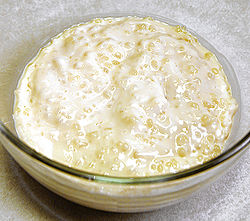Tapioca pudding
 | |
| Type | Pudding |
|---|---|
| Main ingredients | Tapioca, milk or cream or coconut milk |
Tapioca pudding is a sweet pudding made with tapioca and either milk or cream. Coconut milk is also used in cases in which the flavour is preferred or in areas in which it is a commonplace ingredient for cooking. It is made in many cultures with equally varying styles, and may be produced in a variety of ways.[1] Its consistency ranges from thin (runny), to thick, to firm enough to eat with a fork.
The pudding can be made from scratch using tapioca in a variety of forms: flakes, coarse meal, sticks, and pearls. Many commercial packaged mixes are also available.[2]
Ingredients served alongside and put into tapioca pudding has varied over time, an American style of tapioca pudding in the 19th century was known to contain no sugar within the pudding itself, but would be served with sugar and cream on the side.[3] By contrast, some recipes that circulated through the British Empire during the 18th century were known to season their tapioca with cinnamon, red wine, and even bone marrow.[4]
A significant reason for tapioca pudding's popularity was the ease of access in acquiring tapioca balls compared to it's alternative, sago. Tapioca pearls originate from the harvesting of the cassava plant, which required less labor to harvest and grew faster compared to sago.[5] Tapioca pudding would become a prominent staple of the lunches of school children in western countries like Britain, Australia, and the United States. [5]
British schoolchildren have traditionally nicknamed the dish frog spawn, due to its appearance.[6] The Guardian described it as "Britain's most hated school pudding", with names such as fish eyes, frogspawn and eyeball pudding. It is however making a comeback in the 21st century in Michelin-starred restaurants and less exalted places.[2] In southern India a type of dessert pudding known as jawhuarusee payasam made from tapioca pearls is made during festival times.
Tapioca pudding was one of the dishes that Rhode Island army officers ate for their Fourth of July celebrations during the siege of Petersburg.[7]
July 15th is recognized as National Tapioca Pudding Day.[8]
See also
[edit]- Congee
- Sago pudding
- Rice pudding
- Semolina pudding
- Helmipuuro
- Sago soup
- Mango pomelo sago
- List of African dishes
References
[edit]- ^ It's one of the popular desserts or "Tong Shui" of Chinese culture. It is believed to have derived from the Mayan culture and was brought to China in the late 17th century. "Mango & Tapioca Pearls Dessert". christinesrecipes.com. 27 January 2010. Retrieved 6 September 2012.
- ^ a b Balston, Catherine (13 April 2015). "Tapioca: the hated school pudding makes a culinary comeback". The Guardian. Retrieved 25 February 2016.
- ^ "Tapioca Pudding". Tasting History. Retrieved 19 October 2024.
- ^ "Sago and Tapioca Pudding". British Food: A History. 21 August 2023. Retrieved 19 October 2024.
- ^ a b Aquitaine, Ellanor (23 March 2024). "The Rise And Fall Of Tapioca Pudding". Tasting Table. Retrieved 19 October 2024.
- ^ "School Dinners: Top Of The Slops", Sky News, London, 5 August 2003. Retrieved on 6 November 2011.
- ^ "What do Americans eat on July 4th?".
- ^ "National Tapioca Pudding Day". Days Of The Year. 15 July 2024. Retrieved 12 October 2024.
